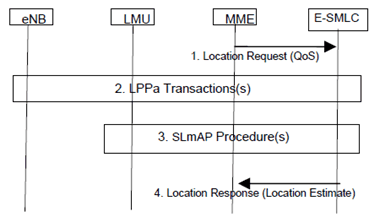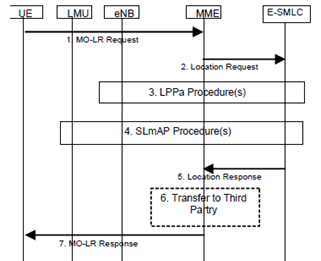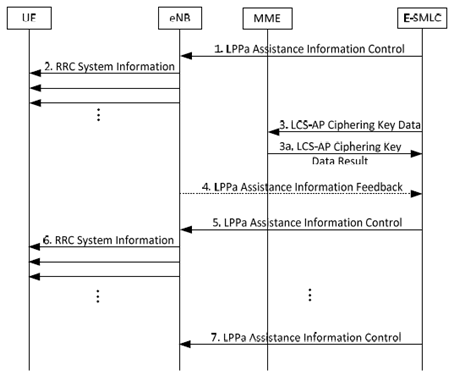Content for TS 36.305 Word version: 18.0.0
7.5 Service Layer Support using combined SLmAP and LPPa Procedures
7.5.1 NI-LR and MT-LR Service Support
7.5.2 MO-LR Service Support
7.6 Procedures for Broadcast of Assistance Data
7.6.1 General
7.6.2 Broadcast Procedures
7.5 Service Layer Support using combined SLmAP and LPPa Procedures p. 41
7.5.1 NI-LR and MT-LR Service Support p. 41
Figure 7.5.1-1 shows the sequence of operations for an NI-LR and MT-LR, starting at the point where the MME initiates the service in the E-SMLC.

Step 1.
The MME sends a location request to the E-SMLC for a target UE and may include associated QoS.
Step 2.
The E-SMLC obtains target UE configuration information from the serving eNode B.
Step 3.
If the E-SMLC needs measurement results for the UE from multiple LMUs, the E-SMLC instigates SLmAP procedures to each LMU.
Step 4.
The E-SMLC returns a location response to the MME with any location estimate obtained as a result of steps 2 and 3.
7.5.2 MO-LR Service Support p. 41
Figure 7.5.2-1 shows the sequence of operations for an MO-LR service, starting at the point where an LCS Client in the UE or the user has requested some location service (e.g., retrieval of the UE's location or transfer of the UE's location to a third party).

Step 1.
The UE sends a NAS level MO-LR request to the MME.
Step 2.
The MME sends a location request to the E-SMLC.
Step 3.
The E-SMLC obtains target UE configuration information from the serving eNode B.
Step 4.
If the E-SMLC needs measurement results for the UE from multiple LMUs, the E-SMLC instigates SLmAP procedures to each LMU.
Step 5.
The E-SMLC returns a location response to the MME with any location estimate obtained as a result of steps 2 and 3.
Step 6.
If the UE requested location transfer to a third party LCS Client, the MME transfers the location received from the E-SMLC in step 5 to the third party as defined in TS 23.271.
Step 7.
The MME sends a NAS level MO-LR response to the UE carrying any location estimate.
7.6 Procedures for Broadcast of Assistance Data p. 42
7.6.1 General p. 42
Positioning assistance data can be included in positioning System Information Blocks (posSIBs) as described in TS 36.331 and TS 36.355. The posSIBs are carried in RRC System Information (SI) messages. The mapping of posSIBs (assistance data) to SI messages is flexibly configurable and provided to the UE in SIB1 (TS 36.331).
For each assistance data element, a separate posSIB-type is defined in TS 36.355. Each posSIB may be ciphered by the E SMLC using the 128-bit Advanced Encryption Standard (AES) algorithm (with counter mode) as described in TS 36.355, either with the same or different ciphering key. The posSIBs which exceed the maximum size limit defined in TS 36.331 shall be segmented by the E SMLC.
7.6.2 Broadcast Procedures p. 42
The general procedures for broadcast of positioning assistance data and delivery of ciphering keys to UEs is described in TS 23.271. This clause defines the overall sequences of operations that occur in the E-SMLC, E-UTRAN and UE.

Step 1.
The E-SMLC sends an LPPa Assistance Data Information Control message to the eNB with an indication to start broadcasting assistance information. The message includes one or more System Information groups, where each group contains the broadcast periodicity and one or more posSIB types together with meta data. Each posSIB type may be ciphered and/or segmented at the E-SMLC. The meta data may include an indication whether the posSIB type in the System Information group is ciphered or not, as well as an indication of an applicable GNSS type.
Step 2.
The eNB includes the received System Information groups in RRC System Information Messages and corresponding scheduling information in SIB1 as described in [12]. The UE applies the system information acquisition procedure according to [12] for acquiring the assistance data information that is broadcasted.
Step 3.
If the posSIB types were ciphered by the E-SMLC, the E-SMLC provides the used ciphering keys, together with a validity time and validity area for each key, to the MME using an LCS-AP Ciphering Key Data message described in TS 29.171. The MME returns a LCS-AP Ciphering Key Data Result message back to the E-SMLC indicating whether the MME was able to successfully store the ciphering data sets. The MME may then distribute successfully stored ciphering keys and their validity times and validity areas to suitably subscribed UEs using a mobility management message as described in TS 23.271. The E SMLC repeats this procedure whenever a ciphering key changes.
Step 4.
At any time after Step 1, the eNB may send a LPPa Assistance Information Feedback message to the E-SMLC providing feedback on assistance information broadcasting. The message may include an assistance information failure list indicating that certain posSIB types could not be configured for broadcasting by the eNB.
Step 5.
If the assistance information in a System Information group changes, the E-SMLC provides updated information in a LPPa Assistance Information Control message.
Step 6.
The eNB replaces the previously stored System Information groups with the new information received at Step 5 and includes the new System Information groups in RRC System Information Messages.
Step 7.
If the E-SMLC wants to abort the broadcast of a System Information Group, it sends a LPPa Assistance Information Control message to the eNB including an indication to stop broadcasting the assistance information.